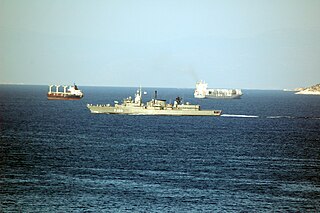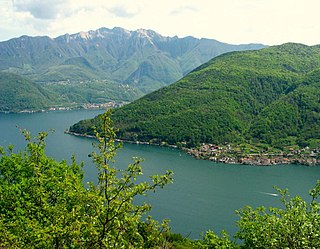Greek National Road 66 is a national highway in southern Greece. It connects Nemea with Levidi, via Skoteini. Near its eastern terminus it intersects with the A7 motorway and then ends at its intersection with EO7.
Greek National Road 66 is a national highway in southern Greece. It connects Nemea with Levidi, via Skoteini. Near its eastern terminus it intersects with the A7 motorway and then ends at its intersection with EO7.

Morea was the name of the Peloponnese peninsula in southern Greece during the Middle Ages and the early modern period. The name was used for the Byzantine province known as the Despotate of the Morea, by the Ottoman Empire for the Morea Eyalet, and later by the Republic of Venice for the short-lived Kingdom of the Morea.

National Road 74 is a single carriageway road in southern Greece. It connects Pyrgos with Tripoli, via Olympia and Vytina. Its length is 141 kilometres (88 mi). It runs through the western and central part of the Peloponnese peninsula, in the regional units Elis and Arcadia.

National Road 82 is a single carriageway road in southern Greece. It connects Pylos with Sparti via Kalamata. It passes through the regional units Messenia and Laconia, on the Peloponnese peninsula. Its length is 110 km.

The Alpheios, sometimes spelled Alfeiós, is the main stream of the Alpheios Valley drainage system, a dendritic type, originating on the north slopes of Mount Taygetus, located in the center of the Peloponnesus of Greece, and flowing to the northwest to the vicinity of Olympia, where it turns to the west and, after being impounded by the Flokas Dam, a hydroelectric facility, empties into the Gulf of Kyparissia of the Ionian Sea south of Pyrgos. The entrance into the gulf through agricultural land and across an unpopulated, sandy beach partially blocked by a spit is hydrologically unspectacular, with the water too shallow to be navigable by any but the smallest craft.

The Hellenic Coast Guard is the national coast guard of Greece. Like many other coast guards, it is a paramilitary organization that can support the Hellenic Navy in wartime, but resides under separate civilian control in times of peace. The officers and the enlisted members of the Coast Guard are regarded as military personnel under Military's Penal Code. It was founded in 1919 by an Act of Parliament and the legal framework for its function was reformed in 1927. Its primary mission is the enforcement of Greek, European and International law in the maritime areas.

Greek frigate Elli (F450) is the lead ship of the Greek Elli class of frigates and the third Hellenic Navy ship by that name. The class is based on the Royal Netherlands Navy's Kortenaer class and was built in a Dutch shipyard; however, unlike later members of its class in the Hellenic Navy, it was not originally in Dutch service, but was sold directly to Greece.

The Ladinian is a stage and age in the Middle Triassic series or epoch. It spans the time between 242 Ma and ~237 Ma. The Ladinian was preceded by the Anisian and succeeded by the Carnian.

The National Observatory of Athens is a research institute in Athens, Greece. Founded in 1842, it is the oldest research foundation in Greece. The Observatory was the first scientific research institute built after Greece became independent in 1829, and one of the oldest research institutes in Southern Europe. It was built around the same period as the United States Naval Observatory.

The Buckinghamshire County Museum is a museum in the centre of Aylesbury, in Buckinghamshire, England. It displays artefacts pertinent to the history of Buckinghamshire including geological displays, costume, agriculture and industry. The museum also features changing art exhibits in the Buckinghamshire Art Gallery.

Kfarshima, also spelled Kfarchima, is a town in the Baabda District of the Mount Lebanon Governorate, southeast of Beirut and is part of Greater Beirut. The town is populated by Lebanese Christians: mainly Melkite Greek Catholic and Maronites, with smaller communities of Greek Orthodox and Protestant Evangelical Christians. Kfarshima was subject to heavy bombing during the Lebanese civil war since it was a primary fault line.

The First Hellenic Republic was the provisional Greek state during the Greek Revolution against the Ottoman Empire. From 1822 until 1827, it was known as the Provisional Administration of Greece, and between 1827 and 1832, it was known as the Hellenic State.

NGC 4710 is an edge-on lenticular galaxy in the northern constellation of Coma Berenices. It was discovered on March 21, 1784 by German-British astronomer William Herschel. This galaxy has a B-band visual magnitude of 11.60 and an angular size of 3.0′ × 0.8′. It is located at a distance of 54.5 ± 3.6 million light-years (16.7 ± 1.1 Mpc) from the Milky Way, and is receding with a heliocentric radial velocity of 1,129 km/s. This is a member of the Virgo Cluster, with a projected offset of ~6° from the cluster center and a cluster crossing time of around two billion years.

Leon (D54) was a Cannon-class destroyer that served with the Greek Navy between 1951 and 1992. The ship had formerly served with the United States Navy under the name USS Eldridge (DE-173), famous for its alleged role in the Philadelphia Experiment.

The National Historical Museum is a historical museum in Athens. Founded in 1882, is the oldest of its kind in Greece. It is located in the Old Parliament House at Stadiou Street in Athens, which housed the Hellenic Parliament from 1875 until 1932. A branch of the National History Museum has been organized and operated there since 2001.
Greek National Road 39 is a national highway of Greece. It connects Tripoli with Gytheio via Sparti. It is connected with the Greek National Road 7 in Tripoli, with the A7 motorway south of Tripoli, with the Greek National Road 82 in Sparti, and with the Greek National Road 86 in Krokees. Until 2016, the EO39 coincided with the European route E961 for most of its length, now it is mainly designated on the A71.

Greek National Road 7 is a single carriageway with at-grade intersections in the Peloponnese region in southern Greece. It connects the cities of Corinth and Kalamata, via Nemea, Argos, Tripoli and Megalopoli. It has been succeeded in importance by the A7 motorway (Corinth–Tripoli–Kalamata).

San Pedro del Romeral is a municipality in Cantabria, Spain.

Iotape, Iotapa or Jotape was a small town of ancient Cilicia, in the district called Selenitis, not far from Selinus. It was later assigned to Isauria where it was the seat of a bishop; no longer the seat of a residential bishop, it remains under the name Iotapa in Isauria a titular see of the Roman Catholic Church. It minted coins dating to the emperors Philip and Valerian.